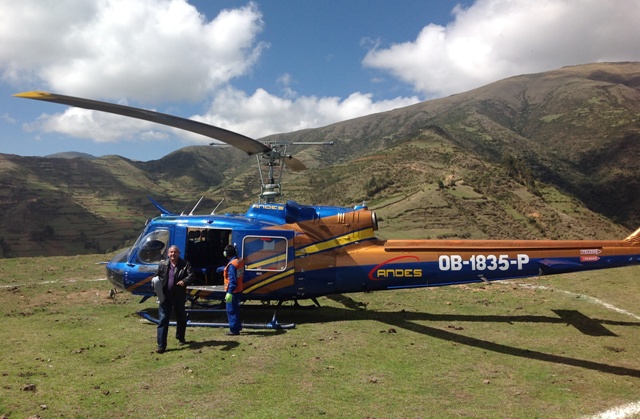VANCOUVER — A long copper-gold intercept suggests that the Ccalla deposit has more mineralization to offer Panoro Minerals (TSXV: PML; US-OTC: POROF), as the company gets set to update the resource estimate at its Cotabambas project in Peru.
Located 50 km west of Cusco in the Peruvian Andes, Cotabambas is already home to 404 million inferred tonnes grading 0.42% copper, 0.23 gram gold per tonne and 2.84 grams silver per tonne. In the year since this estimate, Panoro has drilled 75 new holes into the project’s Ccalla and Azulccacca deposits.
Most of the drill holes probed Ccalla, where last year’s report noted expansion potential, particularly to the east. The report also suggested testing for mineralization downdip from the defined deposit, which would mean deep mineralization to the north.
Instead, drills have returned mineralization from all around the defined deposit.
The latest results include a long, high-grade hit from southwest of the zone. Hole 139 returned 128.9 metres grading 1.29% copper, 0.96 gram gold and 9.4 grams silver, starting from 46 metres downhole. Just 20 metres later the drill hit another 198.6 metres grading 0.48% copper, 0.24 gram gold and 4.7 grams silver. Both intervals comprised primary sulphide mineralization.
Nearby, hole 125 returned 33 metres of oxide mineralization, starting from surface and grading 0.21% copper, 0.27 gram gold and 3.9 grams silver. The oxide zone transitioned into primary sulphide mineralization, with the first intercept returning 96 metres of 0.24% copper, 0.11 gram gold and 2.3 grams silver, while a second interval, starting 153 metres downhole, cut 140 metres averaging 0.46% copper, 0.22 gram gold and 3.2 grams silver. Lower-grade mineralization continued almost uninterrupted to the bottom of the drill hole, more than 600 metres below the surface.
Ccalla may expand to the southwest, but other directions are also promising. To the northwest, hole 120 returned 155 metres of oxide mineralization grading 0.6% copper, starting from surface. The hole transitions into primary sulphide mineralization, cutting 72 metres of 0.32% copper and 0.09 gram gold, followed by 108 metres of 0.34% copper and 0.11 gram gold.
Hole 128 returned similar results from the area. Collared on the northwest side of Ccalla, the hole cut through 172.5 metres of oxide mineralization grading 0.33% copper, 0.1 gram gold and 1.2 grams silver. Fifty metres later it encountered supergene enrichment that returned a 29-metre intercept grading 0.81% copper, 0.39 gram gold and 4.4 grams silver. Below that, primary mineralization produced a 191-metre intercept grading 0.43% copper, 0.19 gram gold and 1.8 grams silver.
Panoro says most of the material northwest of Ccalla is waste. But with results like the ones from holes 120 and 128, this classification could change in the updated resource estimate, which is due out in September.
To the north, two recent holes returned good oxide intercepts: hole 134 cut 52.5 metres of 0.77% copper from surface, while hole 135 cut 53.6 metres of 0.62% copper from surface. Neither hole, however, encountered deeper mineralization.
Moving east from Ccalla, mineralization seems to trend deeper. Six holes from the latest results returned copper intercepts that also carried molybdenum grades. Hole 138, for example, returned seven intercepts between 168 and 583 metres depth, including 55.7 metres grading 0.93% copper, 0.74 gram gold and 6.5 grams silver from 339 metres downhole.
It seems Panoro will have a lot of intercepts to incorporate into its new resource estimate. And the intercepts should continue: the company has three drill rigs operating at Cotabambas, and the current work program includes infill holes to upgrade the resource confidence, as well as stepout holes to expand the resource and exploratory holes to test new targets on the property, which Panoro says remains 80% unexplored.
The company has money to fund the program after raising $15 million in a private placement in March. Panoro sold 27.3 million shares at 55¢ apiece.
Cotabambas is part of the Eocene-Miocene porphyry belt of southern Peru. The belt is home to the Tintaya copper mine operated by Glencore Xstrata (LSE: GLEN), as well as several medium-sized copper deposits in various stages of development. It is also home to Panoro’s other main project, the Antilla copper-moly property, 140 km southwest of Cusco.
“The completion of this important financing during a period of difficult market finance conditions is further validation of the high quality of the Cotabambas project,” said Panoro’s president and CEO Luquman Shaheen. “Panoro’s Cotabambas project — together with Xstrata’s Las Bambas and Antapaccay projects, Hudbay Minerals’ (TSX: HBM; NYSE: HBM) Constancia project, First Quantum Minerals’ (TSX: FM) Haquira project and Grupo Mexico’s Los Chancas project — will together go a long way to achieving Peru’s goal of becoming the world’s premier copper-producing nation.”
Panoro’s share price remained unchanged at 24¢ on news of the latest Cotabambas drill results. The company has a 52-week share price range of 23¢ to 86¢, and 205 million shares outstanding.


Be the first to comment on "Long hit stokes optimism at Cotabambas"